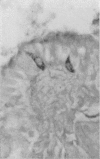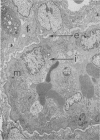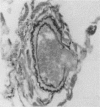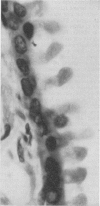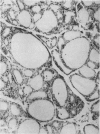Abstract
The morbid anatomical changes which take place in man and animals exposed to the chronic hypoxia of residence at high altitude are briefly reviewed.
Full text
PDF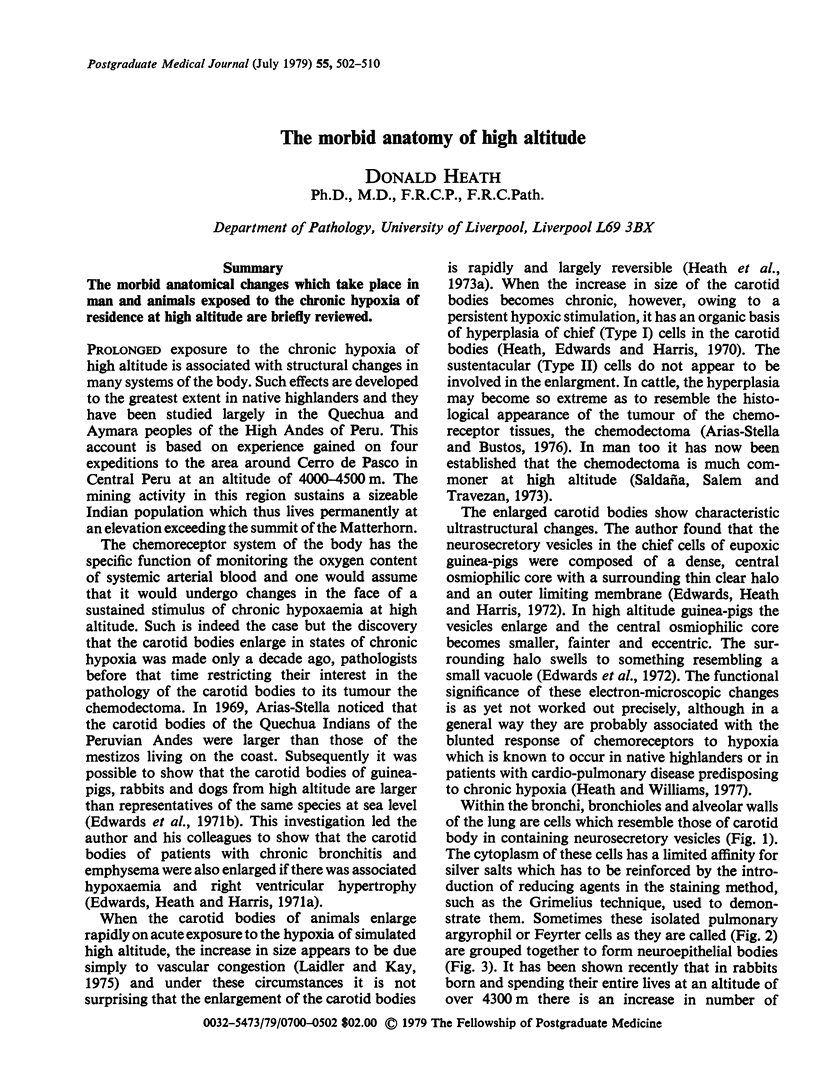
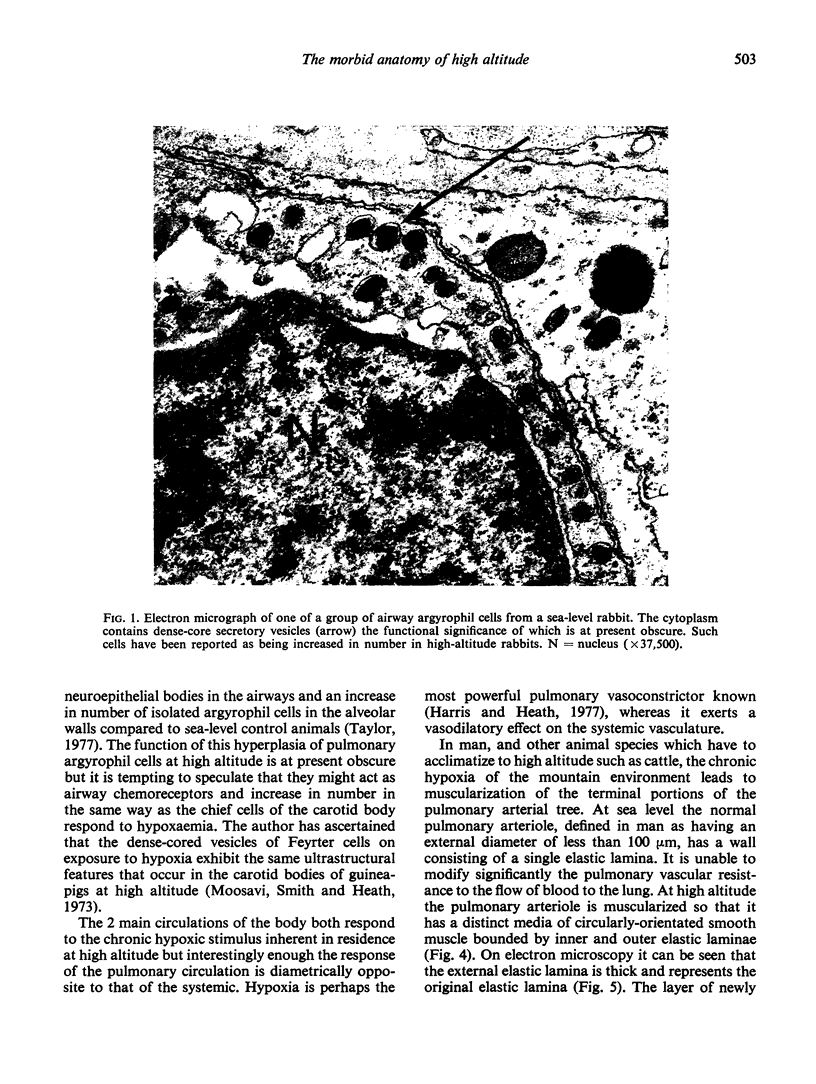

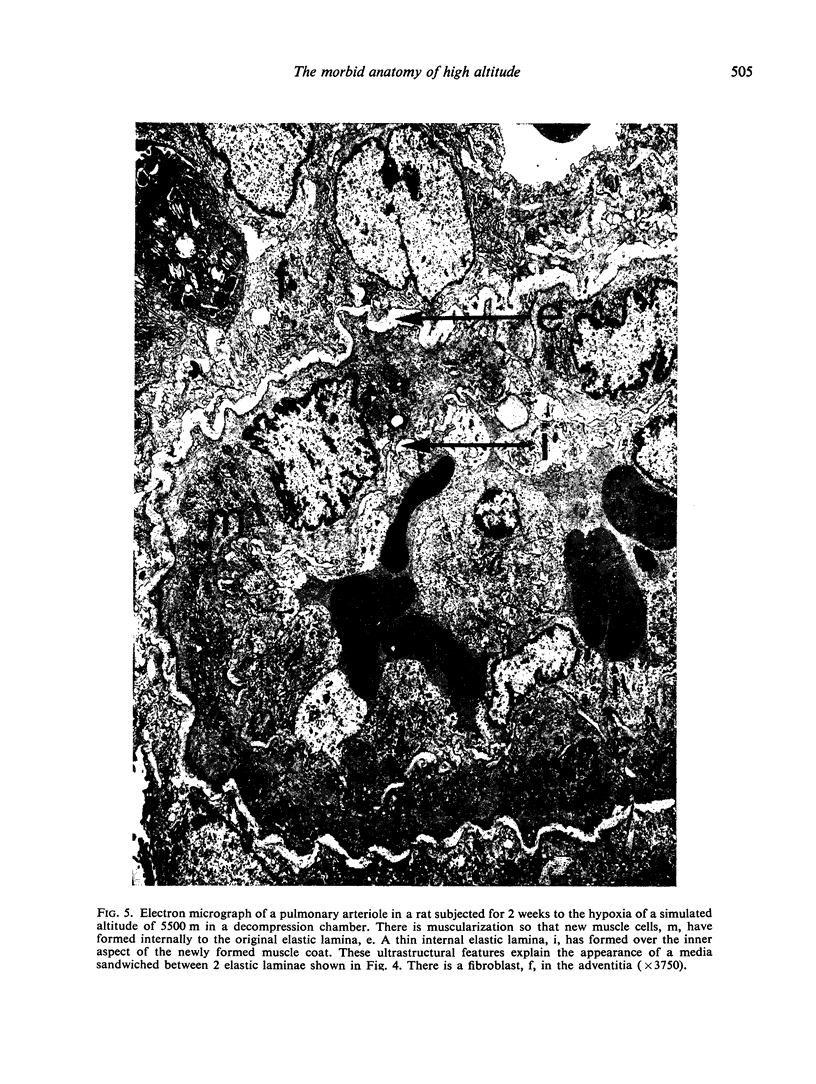
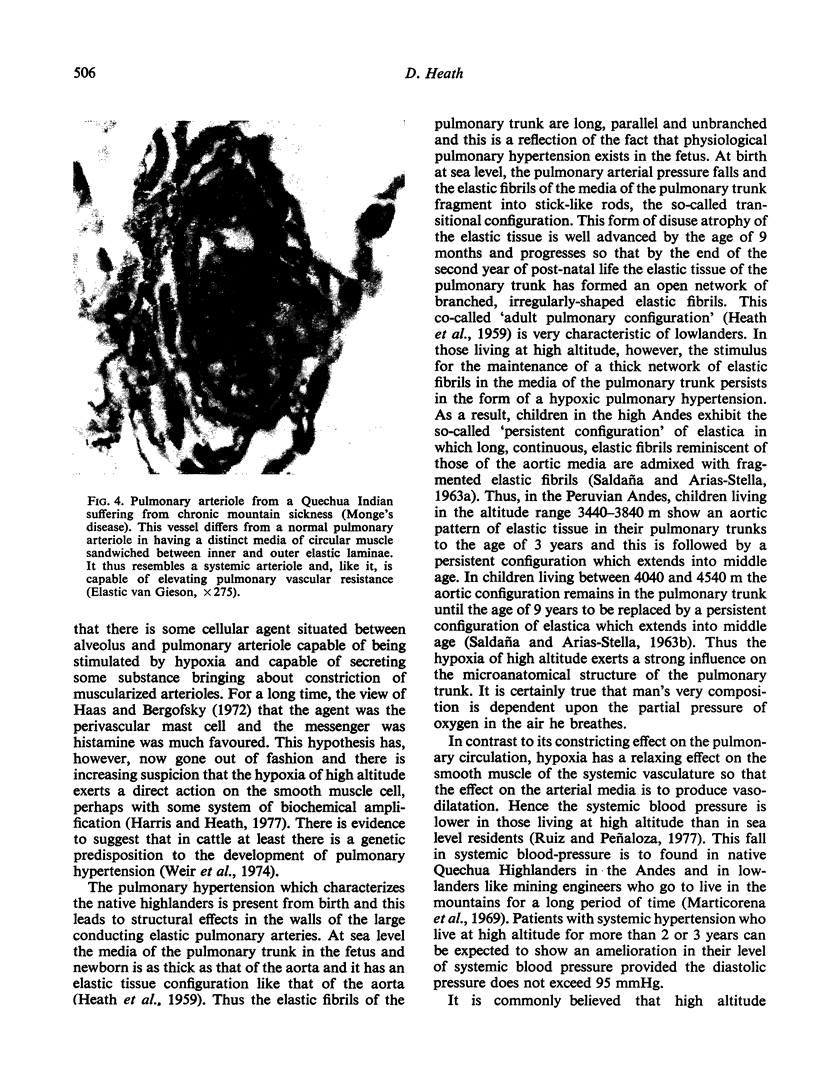
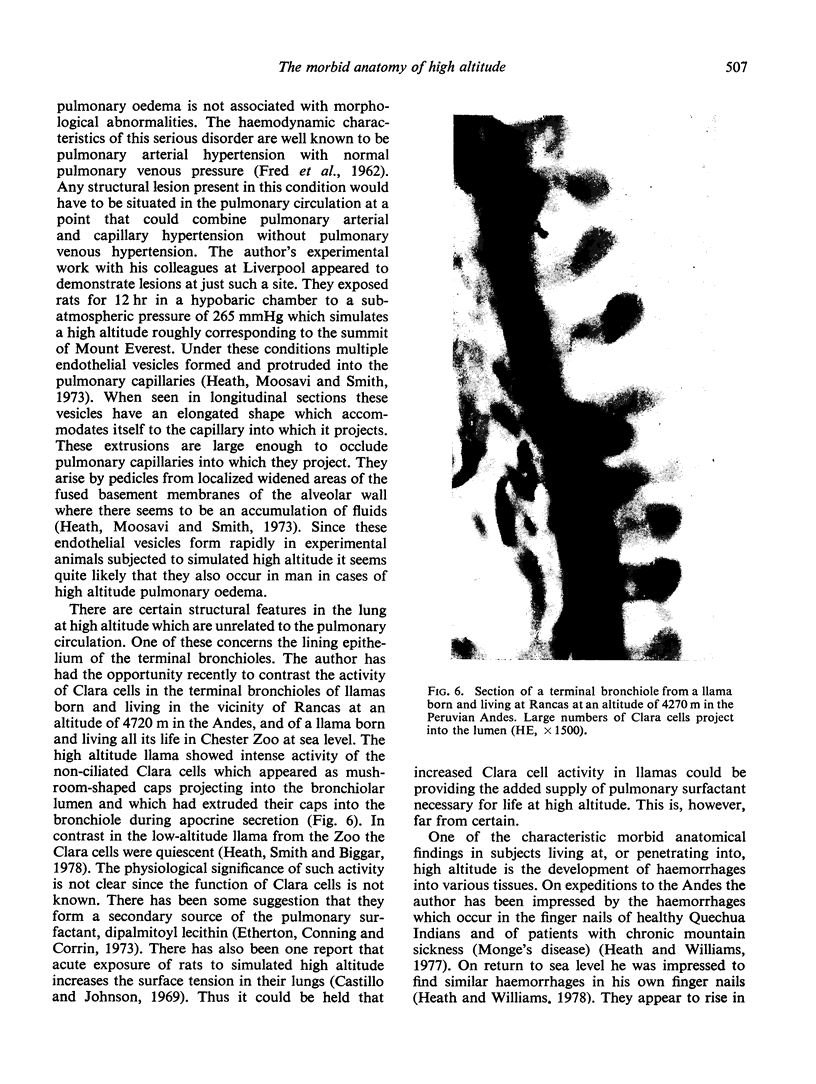

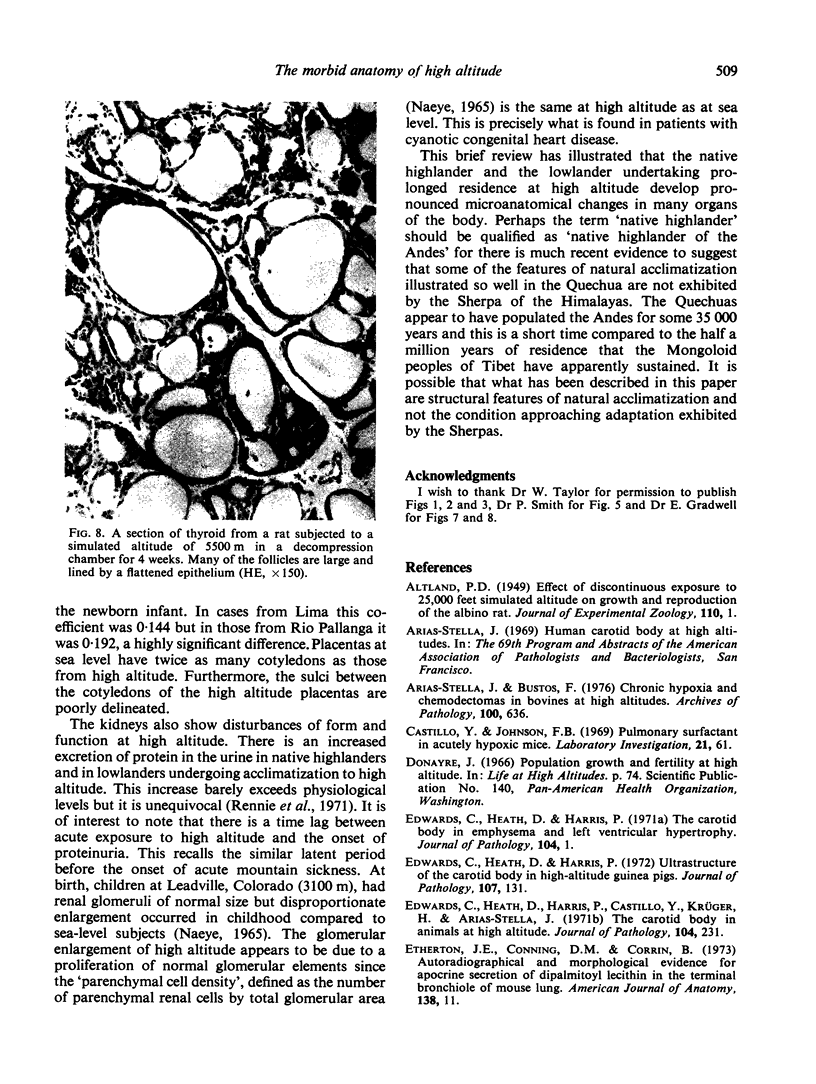
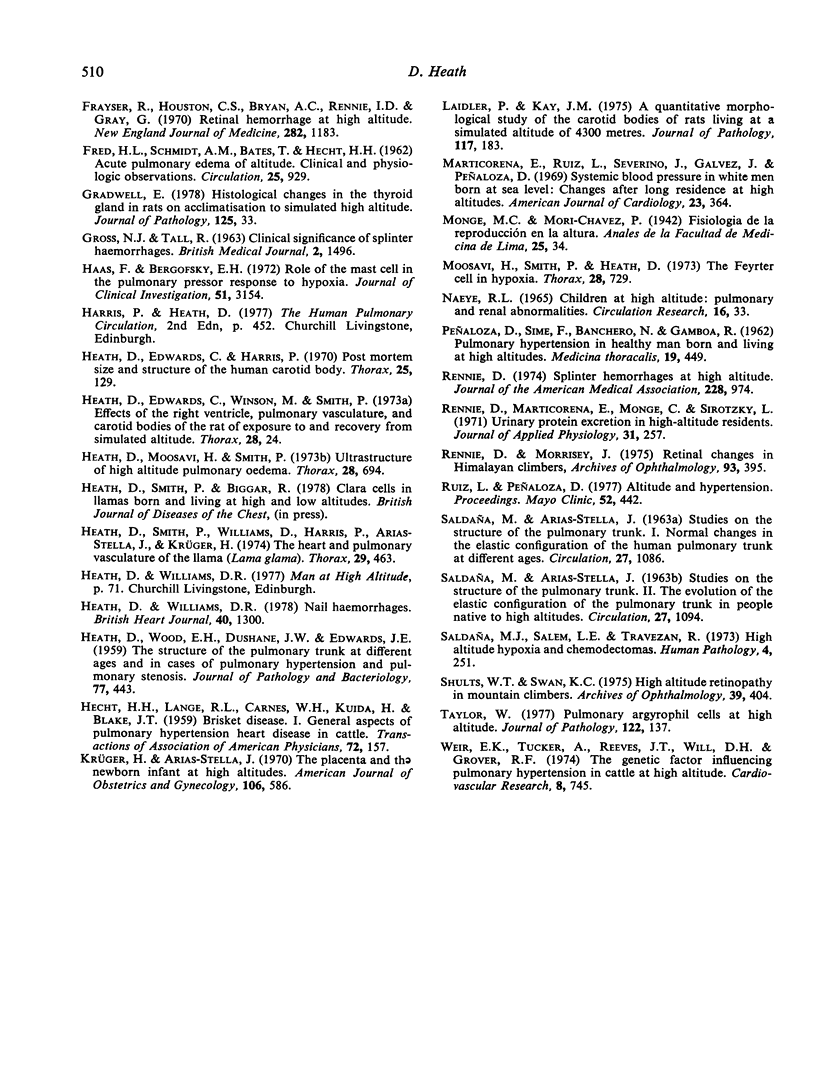
Images in this article
Selected References
These references are in PubMed. This may not be the complete list of references from this article.
- ALTLAND P. D. Effect of discontinuous exposure to 25,000 feet simulated altitude on growth and reproduction of the albino rat. J Exp Zool. 1949 Feb;110(1):1–17. doi: 10.1002/jez.1401100102. [DOI] [PubMed] [Google Scholar]
- Arias-Stella J., Bustos F. Chronic hypoxia and chemodectomas in bovines at high altitudes. Arch Pathol Lab Med. 1976 Dec;100(12):636–639. [PubMed] [Google Scholar]
- Castillo Y., Johnson F. B. Pulmonary surfactant in acutely hypoxic mice. Lab Invest. 1969 Jul;21(1):61–64. [PubMed] [Google Scholar]
- Edwards C., Heath D., Harris P., Castillo Y., Krüger H., Arias-Stella J. The carotid body in animals at high altitude. J Pathol. 1971 Aug;104(4):231–238. doi: 10.1002/path.1711040404. [DOI] [PubMed] [Google Scholar]
- Edwards C., Heath D., Harris P. The carotid body in emphysema and left ventricular hypertrophy. J Pathol. 1971 May;104(1):1–13. doi: 10.1002/path.1711040102. [DOI] [PubMed] [Google Scholar]
- Edwards C., Heath D., Harris P. Ultrastructure of the carotid body in high-altitude guinea-pigs. J Pathol. 1972 Jun;107(2):131–136. doi: 10.1002/path.1711070209. [DOI] [PubMed] [Google Scholar]
- Etherton J. E., Conning D. M., Corrin B. Autoradiographical and morphological evidence for apocrine secretion of dipalmitoyl lecithin in the terminal bronchiole of mouse lung. Am J Anat. 1973 Sep;138(1):11–35. doi: 10.1002/aja.1001380103. [DOI] [PubMed] [Google Scholar]
- Frayser R., Houston C. S., Bryan A. C., Rennie I. D., Gray G. Retinal hemorrhage at high altitude. N Engl J Med. 1970 May 21;282(21):1183–1184. doi: 10.1056/NEJM197005212822106. [DOI] [PubMed] [Google Scholar]
- GROSS N. J., TALL R. CLINICAL SIGNIFICANCE OF SPLINTER HAEMORRHAGES. Br Med J. 1963 Dec 14;2(5371):1496–1498. doi: 10.1136/bmj.2.5371.1496. [DOI] [PMC free article] [PubMed] [Google Scholar]
- Gradwell E. Histological changes in the thyroid gland in rats on acclimatisation to simulated high altitude. J Pathol. 1978 May;125(1):33–37. doi: 10.1002/path.1711250106. [DOI] [PubMed] [Google Scholar]
- HEATH D., WOOD E. H., DUSHANE J. W., EDWARDS J. E. The structure of the pulmonary trunk at different ages and in cases of pulmonary hypertension and pulmonary stenosis. J Pathol Bacteriol. 1959 Apr;77(2):443–456. doi: 10.1002/path.1700770216. [DOI] [PubMed] [Google Scholar]
- Haas F., Bergofsky E. H. Role of the mast cell in the pulmonary pressor response to hypoxia. J Clin Invest. 1972 Dec;51(12):3154–3162. doi: 10.1172/JCI107142. [DOI] [PMC free article] [PubMed] [Google Scholar]
- Heath D., Edwards C., Harris P. Post-mortem size and structure of the human carotid body. Thorax. 1970 Mar;25(2):129–140. doi: 10.1136/thx.25.2.129. [DOI] [PMC free article] [PubMed] [Google Scholar]
- Heath D., Edwards C., Winson M., Smith P. Effects on the right ventricle, pulmonary vasculature, and carotid bodies of the rat of exposure to, and recovery from, simulated high altitude. Thorax. 1973 Jan;28(1):24–28. doi: 10.1136/thx.28.1.24. [DOI] [PMC free article] [PubMed] [Google Scholar]
- Heath D., Moosavi H., Smith P. Ultrastructure of high altitude pulmonary oedema. Thorax. 1973 Nov;28(6):694–700. doi: 10.1136/thx.28.6.694. [DOI] [PMC free article] [PubMed] [Google Scholar]
- Heath D., Smith P., Williams D., Harris P., Arias-Stella J., Krüger H. The heart and pulmonary vasculature of the llama (Lama glama). Thorax. 1974 Jul;29(4):463–471. doi: 10.1136/thx.29.4.463. [DOI] [PMC free article] [PubMed] [Google Scholar]
- Heath D., Williams D. R. Nail haemorrhages. Br Heart J. 1978 Nov;40(11):1300–1305. doi: 10.1136/hrt.40.11.1300. [DOI] [PMC free article] [PubMed] [Google Scholar]
- Krüger H., Arias-Stella J. The placenta and the newborn infant at high altitudes. Am J Obstet Gynecol. 1970 Feb 15;106(4):586–591. doi: 10.1016/0002-9378(70)90045-1. [DOI] [PubMed] [Google Scholar]
- Laidler P., Kay J. M. A quantitative morphological study of the carotid bodies of rats living at a simulated altitude of 4300 metres. J Pathol. 1975 Nov;117(3):183–191. doi: 10.1002/path.1711170308. [DOI] [PubMed] [Google Scholar]
- Marticorena E., Ruiz L., Severino J., Galvez J., Peñaloza D. Systemic blood pressure in white men born at sea level: changes after long residence at high altitudes. Am J Cardiol. 1969 Mar;23(3):364–368. doi: 10.1016/0002-9149(69)90516-5. [DOI] [PubMed] [Google Scholar]
- Moosavi H., Smith P., Heath D. The Feyrter cell in hypoxia. Thorax. 1973 Nov;28(6):729–741. doi: 10.1136/thx.28.6.729. [DOI] [PMC free article] [PubMed] [Google Scholar]
- NAEYE R. L. CHILDREN AT HIGH ALTITUDE: PULMONARY AND RENAL ABNORMALITIES. Circ Res. 1965 Jan;16:33–38. doi: 10.1161/01.res.16.1.33. [DOI] [PubMed] [Google Scholar]
- Rennie D. Letter: Splinter hemorrhages at high altitude. JAMA. 1974 May 20;228(8):974–974. [PubMed] [Google Scholar]
- Rennie D., Marticorena E., Monge C., Sirotzky L. Urinary protein excretion in high-altitude residents. J Appl Physiol. 1971 Aug;31(2):257–259. doi: 10.1152/jappl.1971.31.2.257. [DOI] [PubMed] [Google Scholar]
- Rennie D., Morrissey J. Retinal changes in Himalayan climbers. Arch Ophthalmol. 1975 Jun;93(6):395–400. doi: 10.1001/archopht.1975.01010020409001. [DOI] [PubMed] [Google Scholar]
- Ruiz L., Peñaloza D. Altitude and hypertension. Mayo Clin Proc. 1977 Jul;52(7):442–445. [PubMed] [Google Scholar]
- SALDANA M., ARIAS-STELLA J. Studies on the strcture of the pulmonary trunk. I. Normal changes in the elastic configuration of the human pulmonary trunk at different ages. Circulation. 1963 Jun;27:1086–1093. doi: 10.1161/01.cir.27.6.1086. [DOI] [PubMed] [Google Scholar]
- SALDANA M., ARIAS-STELLA J. Studies on the structure of the pulmonary trunk. II. The evolution of the elastic configuration of the pulmonary trunk in people native to high altitudes. Circulation. 1963 Jun;27:1094–1100. doi: 10.1161/01.cir.27.6.1094. [DOI] [PubMed] [Google Scholar]
- Saldana M. J., Salem L. E., Travezan R. High altitude hypoxia and chemodectomas. Hum Pathol. 1973 Jun;4(2):251–263. doi: 10.1016/s0046-8177(73)80012-7. [DOI] [PubMed] [Google Scholar]
- Shults W. T., Swan K. C. High altitude retinopathy in mountain climbers. Arch Ophthalmol. 1975 Jun;93(6):404–408. doi: 10.1001/archopht.1975.01010020418003. [DOI] [PubMed] [Google Scholar]
- Taylor W. Pulmonary argyrophil cells at high altitude. J Pathol. 1977 Jul;122(3):137–144. doi: 10.1002/path.1711220304. [DOI] [PubMed] [Google Scholar]
- Weir E. K., Tucker A., Reeves J. T., Will D. H., Grover R. F. The genetic factor influencing pulmonary hypertension in cattle at high altitude. Cardiovasc Res. 1974 Nov;8(6):745–749. doi: 10.1093/cvr/8.6.745. [DOI] [PubMed] [Google Scholar]




